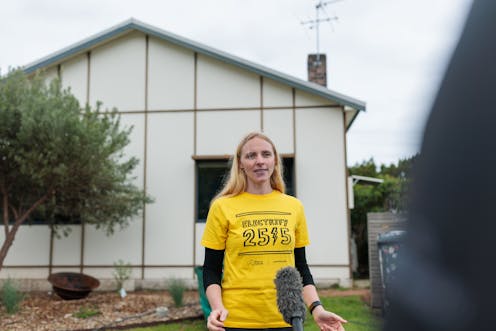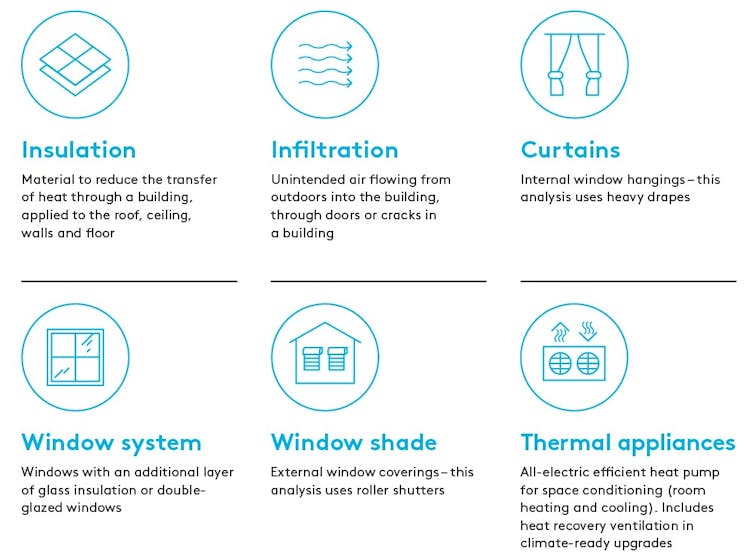 EndeavourEnergy
EndeavourEnergyIn Australia and overseas, it’s clear that homes without gas – running on clean energy – are healthier, have cheaper power bills, and produce lower greenhouse emissions.
The emissions part is crucial. Collectively, homes are responsible for 10% of Australia’s greenhouse emissions. But how do we get Australia’s 11 million homes to ditch gas and switch to electricity for cooking, hot water and home heating?
The current approach is slow and piecemeal. State and local governments offer incentives to individual households, but few adopt them. For those that do, little coordinated support and guidance is available. The households must deal with suppliers and tradies on their own, which can be a frustrating and lonely process.
A pilot project to electrify 500 homes in a single postcode south of Sydney could show a better way. After a two-year campaign by residents, “Electrify 2515” has won A$5.4 million in federal funding, along with industry support. Challenges remain, but this pilot promises to demonstrate how household electrification can be accelerated and coordinated at scale.
As independent climate transitions specialists within Monash University, Climateworks Centre has no direct involvement in this project. But our ongoing Renovation Pathways Program focuses on ways to decarbonise Australia’s existing houses and bring about a national renovation wave. So we are watching with keen interest.
Testing extra incentives
The 2515 postcode sits between Wollongong and Sydney in New South Wales. It covers the suburbs of Austinmer, Clifton, Coledale, Scarborough, Thirroul and Wombarra.
The pilot encourages households to retire three types of gas appliance: water heaters, space heaters and cookers. Financial subsidies of up to $1,000 off electric hot water systems, reverse-cycle air conditioners and induction cooktops, and up to $1,500 off home batteries, are available. Higher subsidies are available to low-income households.
Successful applicants receive the subsidies as a discount on the purchase price of these new electrical appliances, rather than a rebate. Money for this is coming from the federal government’s Australian Renewable Energy Agency (ARENA).
Such incentives prompt households within a single community to make the switch together, retiring their electric appliances before their gas appliances fail or break, speeding up the transition.
A fully subsidised smart energy device, valued at around $1,500, is also installed in every home to track and optimise energy use. Subsidies are also available for upgrades to switchboards where required to meet modern safety standards.
Rooftop solar and electric vehicle chargers can also be purchased through the pilot, but will not be subsidised.
 How it works.
Electrify 2515
How it works.
Electrify 2515
The 2515 difference
2515 is not the first community to rally behind clean energy. Grassroots initiatives are scattered around the country, such as in Yackandandah in northeast Victoria, Parkes in central west NSW, and Broken Hill in far west NSW.
Home energy pilot projects are also already underway through the Cooperative Research Centre Race2030, which partners with industry and research institutions. But these initiatives, along with those at a state and local government level, tend to recruit individual households across a wider geographic area.
In contrast, Electrify 2515 offers holistic support for households within a community. It is not driven by a single government program, or by a gas supply problem – which was the case for the people of Esperance in Western Australia.
By electrifying 500 homes in a single community, Electrify 2515 will provide a tangible measure of what’s required to drive rapid household electrification. The main challenge isn’t technological – it’s social. The technology is here. Getting the social drivers and settings right, at scale, is the key.
The holistic approach will demonstrate what consumers need to make the shift from gas to electricity. This includes what conversations are needed and which incentives enable all households to act in a coordinated way.
The bright side of a community approach
The whole-of-community focus brings technical and financial advantages.
After completing an application form and receiving an offer, households receive guidance and support from the installation partner Brighte, a commercial company that provides consumer loans for clean energy appliances such as solar panels and batteries. The service streamlines the decision-making process, which is often the biggest barrier stopping households from progressing with electrification.
Being able to work with a larger number of homes at once is likely to streamline and scale up installation with dedicated teams of installers and tradespeople.
It also helps build households’ trust in literature about payback times and financial benefits through friendly neighbourhood conversations and, importantly, through access to local real-world evidence, not just theory.
Thermal efficiency is also key
The electrification pilot is a solid starting point, especially for a community in a relatively mild coastal climate such as postcode 2515.
For homes in more extreme climates, or for inefficient older homes – which a lot of Australia’s homes sadly are – the fundamental thermal efficiency of the building must be improved alongside electrification of appliances.
The thermal efficiency of homes can be improved by insulating ceilings, walls and floors, double-glazing windows and sealing gaps. These measures make a home more comfortable for occupants. They can also reduce peak demand on the energy network and save on household energy bills.
Electrify 2515 currently focuses on appliance upgrades but adding thermal efficiency upgrades could take it to the next level. Without these upgrades, there is a risk of households in harsher climates using more electricity in a heatwave if homes are draughty and inefficient.
 There are various ways to upgrade a home’s capacity to stay cool in summer and warm in winter.
Climateworks Centre, 2023, Climate-ready homes: Building the case for a renovation wave in Australia.
There are various ways to upgrade a home’s capacity to stay cool in summer and warm in winter.
Climateworks Centre, 2023, Climate-ready homes: Building the case for a renovation wave in Australia.
When paired with electrification, thermal upgrades could save Australian households around $2,200 annually on their energy bills (based on 2023 gas and electricity prices), according to Climateworks Centre analysis.
Projects like Electrify 2515 should include both home thermal efficiency improvements and electrification efforts, particularly for communities in harsher climates in order to maximise benefits to households.
Electrification challenges
Electrify 2515 caters for low-income households, by offering higher subsidies to households in the lowest 25% income percentile to ensure these groups comprise 25% of community buy-in.
Renters are encouraged to put their hand up too. But it may still be challenging to encourage their landlords to invest in upgrades.
Further challenges include decarbonising homes that cannot generate electricity from rooftop solar panels due to being shaded by taller buildings or trees. This can sometimes be an issue for homes in colder winter climates with higher annual energy demands, such as Victoria, Tasmania and the ACT.
Building momentum for widescale rollout
The technology for all-electric homes exists. Now we must identify the key social drivers and settings required to spur Australia’s electrification wave.
Electrify 2515 is a promising approach. It’s a way to build momentum, showcase technology at scale, and prompt meaningful discussions around the benefits and challenges of getting off gas.
This program, and others like it, can provide a tangible real-world foundation to bring about bills savings, emissions reductions and healthier homes across Australia. And it will help ensure no one is left behind.
Climateworks Centre is a part of Monash University. It receives funding from a range of external sources including philanthropy, governments and businesses.

 3 hours ago
16
3 hours ago
16

